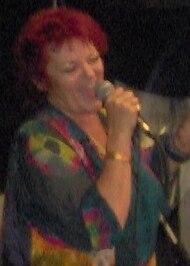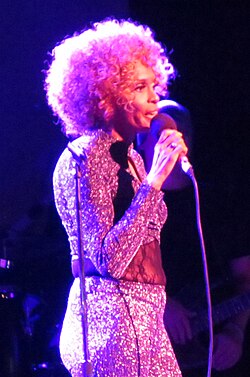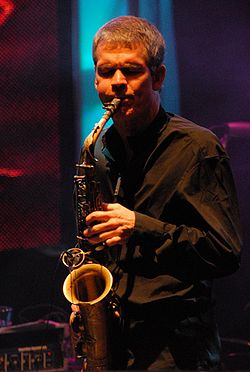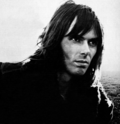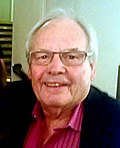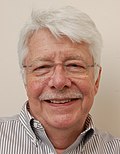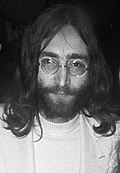Top Qs
Timeline
Chat
Perspective
List of David Bowie band members
From Wikipedia, the free encyclopedia
Remove ads
David Bowie was an English singer-songwriter and musician who started his career as a member of a band called the Konrads, under the name David or Davie Jones, in 1962.[1] Since starting his solo career in 1964, his solo band has gone under many names, including, the Hype, Arnold Corns, the Spiders from Mars and Tin Machine. At the time of his retirement from solo live performances in 2004, his band included himself on vocals, guitars, stylophone and harmonica, Earl Slick on guitar, Gerry Leonard on guitar, keyboards and vocals, Gail Ann Dorsey on bass guitar and vocals, Sterling Campbell on drums, Mike Garson on piano and keyboards and Catherine Russell on keyboards, percussion, guitar and vocals.
(left to right) Mike Garson (off left), Earl Slick, Mark Plati, Sterling Campbell (on drums), David Bowie, Catherine Russell (on keyboards), Gail Ann Dorsey and Gerry Leonard.
David Bowie performing with his band in 2002
Remove ads
History
Summarize
Perspective
1960s and 70s
Bowie formed his first band, the Konrads, in 1962 at the age of 15 under his birth name David Jones. The Konrads playing guitar-based rock and roll at local youth gatherings and weddings, and had a varying line-up of between four and eight members. Bowie's childhood friend, George Underwood was among them,[1] as was drummer Dave Crook and guitarist Neville Wills. Later members of the Konrads included drummer Dave Hadfield, bassist Rocky Shahan and vocalists Roger Ferris and Christine & Stella Patton. Bowie left the Konrads after disagreements over musical styles while recording.[2]
Following the Konrads he was a member of a trio called the Hooker Brothers, or Dave's Reds and Blues with Underwood on guitar and harmonica, Bowie (still under the name Davie Jones) on vocals and saxophone and drummer Viv Andrews. This band existed from July to November 1963.[3] He started his solo career with the single "Liza Jane" which was credited to Davie Jones with the King Bees,[4][5] a band which included Jones and Underwood and also lead guitarist Roger Bluck, bassist Dave Howard and drummer Robert Allen.[6]
Jones' next band was the Manish Boys which included Johnny Flux on guitar, Paul Rodriguez on tenor saxophone and trumpet, Woolf Byrne on baritone saxophone, Bob Solly on keyboards, John Watson on bass guitar and Mick White on drums. Jones left this band in February 1966. They released the single "I Pity the Fool" which featured Jimmy Page on lead guitar.[7]
Jones joined a band called the Lower Third in early 1965,[8] the band included Denis "Tea-Cup" Taylor on lead guitar, Graham Rivens on bass guitar and Les Mighall on drums. Mighall later left the band and was replaced by Phil Lancaster. The band fell apart later that year.[9] Jones changed his stage name to David Bowie to disambiguate himself from Davy Jones on The Monkees.[10] Under his new moniker, he started a band called David Bowie and the Buzz, in 1966, the core members of the Buzz were bass guitarist Derek "Dek" Fearnley, keyboard player Derek "Chow" Boyes, and drummer John "Ego" Eager,[11] with earlier guitarists being John Hutchinson[12] and Billy Bray. The band later broke up in November of the same year.[13] The Lower Third contributed to Bowie self-titled debut album in 1967, alongside session musician Big Jim Sullivan.[14][15]
In early 1967 Bowie joined The Riot Squad, which consisted of Bowie (vocal, guitar, mouth-harp), Rod "Rook" Davies (lead guitar), Brian "Croak" Prebble (bass, vocals), Bob Evans (tenor saxophone, flute, vocals), George "Butch" Davis (keyboards) and Derek "Del" Roll (drums).[16] The band broke up later that year after recording several songs including a cover of the Velvet Underground's "I'm Waiting for the Man".[17]

In May 1968, Bowie performed on John Peel's Top Gear, with a backing band called the Tony Visconti Orchestra, which included Herbie Flowers (bass), Barry Morgan (drums), John McLaughlin (guitar), Alan Hawkshaw (keyboards) and Visconti and Steve Peregrin Took (backing vocals). This performance was released on the album Bowie at the Beeb in 2000.[18]
Following his stint with The Riot Squad, Bowie formed folk influenced trio Turquoise, with himself, Hermione Farthingale, and former Misunderstood guitarist Tony Hill in September 1968.[19] The band was later renamed to Feathers following Tony Hill being replaced by former Buzz guitarist John "Hutch" Hutchinson, and later to just David Bowie & Hutch after Farthingale's departure.[19]
Bowie released his second self-titled album in 1969, the album included Junior's Eyes members, guitarists Tim Renwick (who also played woodwind) and Mick Wayne bassist John "Honk" Lodge and drummer John Cambridge, other musicians who played on this album were, guitarist Keith Christmas, keyboardist Rick Wakeman, bassists Tony Visconti (who also played woodwind and was the producer) and Herbie Flowers, harmonicist Benny Marshall and cellist and arranger Paul Buckmaster.[20][21] The members of Junior's Eyes also performed with Bowie on the Dave Lee Travis Show in October 1969, prior to the albums release, the recording was also released on Bowie at the Beeb in 2000.[18]
In January 1970 Bowie played on Scottish TV show Cairngorm Ski Night, with producer/bassist Tony Visconti, and percussionist Tex Johnson.[22] Bowie's next backing band was called the Hype, it included originally included guitarist Mick Ronson, bassist Tony Visconti and drummer John Cambridge.[23] This line-up appeared on The Sunday Show introduced by John Peel in February 1970 and on Sounds of the 70s: Andy Ferris in April 1970,[18] before Cambridge was replaced by Mick "Woody" Woodmansey, this line-up appeared on Bowie's third album The Man Who Sold the World with Ralph Mace on Moog. The band was occasionally joined by Mark Pritchett on guitar. one performance on In Concert with John Peel was billed as David Bowie and friends and also included Pritchett, backing vocalists George Underwood, Dana Gillespie and Geoffrey Alexander and also bassist Trevor Bolder.[18] All performances were included on Bowie at the Beeb.[18]

Bowie's next backing band included guitarist Mick Ronson, bassist Bolder and drummer Woodmansey from his David Bowie and Friends band. The band was also augmented by pianists Rick Wakeman and Tom Parker, for some shows each. The then unnamed band was later named the Spiders from Mars and was going to included Wakeman but he declined and joined Yes.[24] The band contributed to Bowie's album The Rise and Fall of Ziggy Stardust and the Spiders from Mars, the band was later augmented by various pianists in 1972, including Nicky Graham,[25] Matthew Fisher,[26] Robin Lumley[26] and Mike Garson[27] (who would be a long-time member of the Bowie band). Into 1973, the band was later augmented by Garson, backing vocalist Warren Peace, rhythm guitarist John Hutchinson and saxophonists Ken Fordham and Brian Wilshaw,[28] this line-up contributed to the album Aladdin Sane in 1973, alongside backing vocalists Linda Lewis and Juanita "Honey" Franklin.[29][30] Most musicians from the Spiders From Mars contributed to Bowie's musical, The 1980 Floor Show in October 1973,[31] and his album Pin Ups in the same month.[32][33]
Bowie's Diamond Dogs, featured keyboardist Mike Garson, bassist Herbie Flowers, drummers Ansley Dunbar and Tony Newman and guitarist Alan Parker.[34][35] For the Diamond Dogs Tour in 1974, he employed an entirely different band with only Garson and Peace being retained.[36] Other members included keyboardist Michael Kamen, guitarist Earl Slick, saxophonists David Sanborn and Richard Grando, returning bassist Herbie Flowers, percussionists Tony Newman and Pablo Rosario and new backing vocalist Gui Andrisano,[37] this tour band existed between June and July and featured on the live album David Live, in September the band was expanded with new guitarist Carlos Alomar (who played alongside Slick and also acted as musical director), bassist Doug Rauch and drummer Greg Errico,[37] as well as backing vocalists Ava Cherry, Robin Clark, Anthony Hinton, Diane Sumler and Luther Vandross.[37]
Between October and December, in a tour called The Soul/Philly Dogs Tour, the band included new members Emir Ksasan (bass) and Dennis Davis (drums) with Kamen, Rauch, Errico and Andrisano departing.[37] Various musicians from this tour contributed to Young Americans, as well as a guest appearance from John Lennon.[38][39] Bowie's next album, Station to Station (1976), included touring members Carlos Alomar, Earl Slick, Dennis Davis and Warren Peace, as well as George Murray (bass guitar), Roy Bittan (piano, organ) and Harry Maslin (melodica, synthesiser, vibraphone, baritone sax).[40][41] Bowie's new tour, Isolar, it included guitarist Carlos Alomar, Stacy Heydon, bassist George Murray, drummer Dennis Davis and keyboardist Tony Kaye.[42]
Low (1977) included Alomar, Davis and Murray and session contributors Brian Eno, Ricky Gardiner, Roy Young, Eduard Meyer, J. Peter Robinson and Paul Buckmaster and guests Iggy Pop and Mary Visconti.[43][44] Similar personnel contributed to "Heroes" (1977) and guest musicians Robert Fripp (King Crimson) and Tony Visconti (producer).[45][46]
The touring rebooted in 1978 as the Isolar II tour, It included a slightly different band, included the returning Alomar, Davis and Murray, with new members Adrian Belew (lead guitar), Roger Powell (keyboards, synthesizer; who was replaced by Dennis Garcia for shows in November), pianist Sean Mayes and violinist Simon House.[47] This was Bowie's last tour of the 70s, some performances were released on Stage.[48] Many musicians from this tour contributed to Lodger (1979).
1980s to 2000s
Scary Monsters (and Super Creeps) (1980) included Davis, Murray and Alomar.[49][50] Following the release of Scary Monsters (and Super Creeps), Bowie was expected to tour; however, the murder of John Lennon in December 1980 made Bowie cancel tour plans.[51][52] His first tour in 5 years, the Serious Moonlight Tour, kicked off in May 1983. The band included returning members Carlos Alomar and Earl Slick, and also bassist Carmine Rojas, drummer Tony Thompson, keyboardist Dave Lebolt, woodwind players Steve Elson, Stan Harrison and Lenny Pickett and backing vocalists George and Frank Simms.[53]
Let's Dance (1983) included some touring members, including Carmine Rojas, Tony Thompson, Stan Harrison, Steve Elson, George and Frank Simms, and also guest lead guitarist Stevie Ray Vaughan, bassist Bernard Edwards, percussionists Omar Hakim and Sammy Figueroa, keyboardist Robert Sabino, saxophonist Robert Aaron, trumpeter Mac Gollehon and backing vocalist David Spinner. The album was produced by Nile Rodgers who also played guitar on the album.[54] Similar personnel contributed to Tonight (1984).[55][56]
Bowie performed at Live Aid on 15 July 1985 at Wembley Stadium, with a band including guitarist Kevin Armstrong, keyboardist Thomas Dolby, saxophonist Clare Hirst, bassist Matthew Seligman, percussionists Neil Conti and Pedro Ortiz, and backing vocalists Tessa Niles and Helena Springs.[57][58] Never Let Me Down (1987) included mainly touring personnel with some session musicians.[59]
The Glass Spider Tour started in May 1987 and concluded in November, the tour band included guitarist Peter Frampton and Carlos Alomar, bassist Carmine Rojas, drummer Alan Childs and multi-instrumentalists Erdal Kızılçay (keyboards, trumpet, congas, violin, backing vocals) and Richard Cottle (keyboardist, saxophone, tambourine, backing vocals).[60]

Bowie was a member of hard rock outfit Tin Machine from 1988 to 1992, the band also included Reeves Gabrels (lead guitar, backing vocals), Tony Fox Sales (bass guitar, backing vocals) and Hunt Sales (drums, backing vocals). They released two albums and toured in support of each, on their first tour, from June to July 1989, they were augmented by Kevin Armstrong (rhythm guitar, backing vocals)[61] and by Eric Schermerhorn on their second tour from October 1991 to February 1992.[62]
Between Tin Machine's two tours, Bowie embarked on the Sound+Vision Tour between March and September 1990. The tour band included returning members Adrian Belew and Erdal Kızılçay (now on bass), as well as new members Rick Fox (keyboards) and Michael Hodges (drums).[63] Black Tie White Noise (1993) included various session musicians, including guest lead guitar from Spiders from Mars guitarist Mick Ronson,[64][65] who died later that year.[66] The Buddha of Suburbia (1993) included only Bowie and Kızılçay as well as some contributions from members of the band 3D Echo ((Rob Clydesdale, Gary Taylor, Isaac Daniel Prevos)t, Mike Garson and Lenny Kravitz.[67][68]
Outside (1995) included many past, present and future touring members.[69][70] His next tour was the Outside Tour between September 1995 and September 1996. The tour band was larger than the Sound+Vision band, it included the returning Carlos Alomar, Mike Garson and George Simms (now on keyboards) as well as Tin Machine guitarist Reeves Gabrels and new members Gail Ann Dorsey (bass guitar, vocals), Zack Alford (drums) and Peter Schwartz (synthesizer).[71]

Earthling (1997) featured only touring personnel.[72][73] The Earthling Tour included only retained members Gabrels, Dorsey, Alford and Garson, it ran from June to November 1997.[74] Hours (1999) also included mainly touring personnel,[75][76] the Hours Tour, included lead guitarist Page Hamilton, rhythm guitar Mark Plati, bassist Gail Ann Dorsey, drummer Sterling Campbell, keyboardist Mike Garson and backing vocalists Holly Palmer and Emm Gryner.[77] Reeves Gabrels performed at one show on the tour before being replaced by Hamilton due to personal differences.[78] The tour ran between October and December 1999.
The Mini Tour included only four dates, all in June 2000, and featured the same tour band except Hamilton, who was replaced by the returning Earl Slick.[79] It included a show at Glastonbury which was later described as "iconic".[80] Heathen (2002) included various session musicians, including longtime producer Tony Visconti drummer Matt Chamberlain, guitarist David Torn, violinist Lisa Germano, bassist Tony Levin, and guest guitarists Pete Townshend (The Who) and Dave Grohl (Foo Fighters).[81][82] Around this time, music that was later released on Toy (2019) was recorded.[83]
Bowie's next tour was the Heathen Tour, between June and October 2002, which included a similar band except Palmer and Gryner departed and Catherine Russell (keyboards, percussion, backing vocals) and Gerry Leonard (guitar, keyboards, backing vocals) joined.[84] Reality (2003) included all of his touring band as well as David Torn, Visconti, Chamberlain Mario J. McNulty and Carlos Alomar. Bowie's final tour, A Reality Tour, included the same band as his previous tour, it started in October 2003 and concluded in June 2004.[85]
Following the conclusion of this tour, Bowie did three more live performances. First was at Condé Nast Fashion Rocks on 8 September 2005, which featured three songs first was "Life on Mars" with piano backing from Mike Garson, and the last two were "Wake Up" and "Five Years", both with Indie rock band Arcade Fire.[86] Next was with David Gilmour at the Royal Albert Hall in May 2006 where he performed on Pink Floyd songs "Arnold Layne" and "Comfortably Numb".[87] His final performance was at the Hammerstein Ballroom, NYC as part of the Keep a Child Alive's annual Black Ball fundraiser, where he performed "Wild Is The Wind" (with Mike Garson), "Fantastic Voyage" (with Alicia Keys’' band) and "Changes" (with Alicia Keys).[88] He even announced a comeback gig in 2007 as part of New York's High Line festival, but it was cancelled a few months later without explanation.[88]
Bowie releases two more studio albums The Next Day (2013) and Blackstar (2016) the former included former touring members and other guests,[89] the latter included session musicians Donny McCaslin (woodwind), Jason Lindner (keyboards), Tim Lefebvre (bass), Mark Guiliana (drums), Ben Monder (guitar), James Murphy (percussion) and Erin Tonkon (backing vocals). the album was co-produced with longtime collaborator Tony Visconti.[90] It was his final album released in this lifetime, following his death in January 2016. Various posthumous live albums and a studio album, called Toy, have been released following his death.
Remove ads
Members
Remove ads
Timeline
Touring/session

Session

Line-ups
Summarize
Perspective
Remove ads
Additional session musicians
Summarize
Perspective
Musicians that are either credited as additional personnel or contributed to fewer than 4 tracks on an album.
Remove ads
References
Wikiwand - on
Seamless Wikipedia browsing. On steroids.
Remove ads














